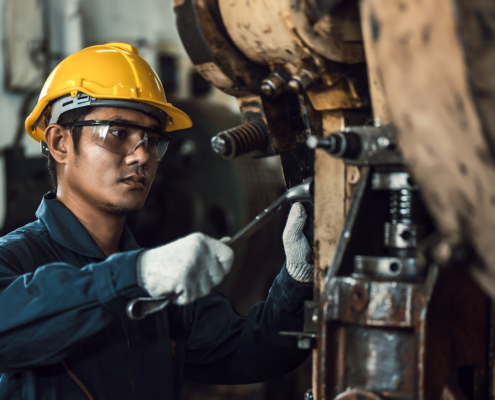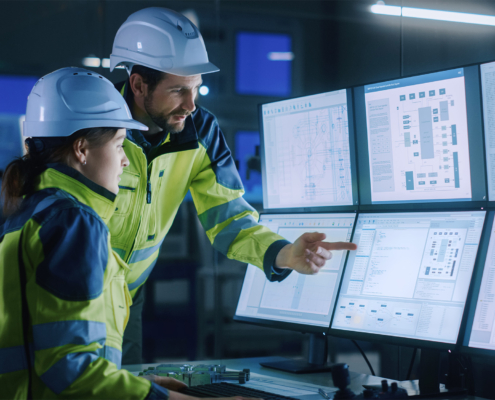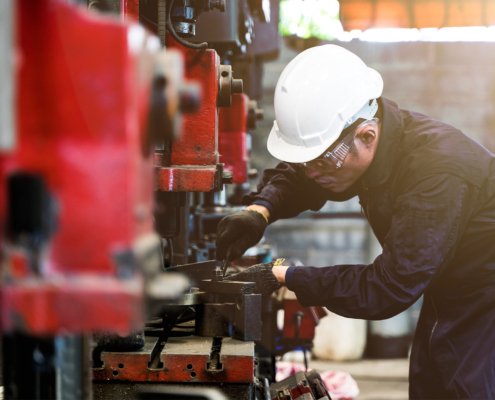 https://www.sbmech.com/wp-content/uploads/2024/09/Group-of-factory-job-workers-using-machine-equipment-in-manufacturing-workshop.jpg
1250
2000
Abstrakt Marketing
/wp-content/uploads/2023/10/cropped-Smith-Boughan_Logo-Formated-Lima-13-1030x269.jpg
Abstrakt Marketing2024-09-24 09:08:182024-11-19 11:07:52Understanding Control in Industrial Maintenance
https://www.sbmech.com/wp-content/uploads/2024/09/Group-of-factory-job-workers-using-machine-equipment-in-manufacturing-workshop.jpg
1250
2000
Abstrakt Marketing
/wp-content/uploads/2023/10/cropped-Smith-Boughan_Logo-Formated-Lima-13-1030x269.jpg
Abstrakt Marketing2024-09-24 09:08:182024-11-19 11:07:52Understanding Control in Industrial MaintenanceNavigating the complexities of industrial maintenance compliance can be challenging, but it’s crucial for ensuring safety, efficiency, and regulatory adherence. Compliance guidelines are designed to protect workers, equipment, and the environment, yet understanding and implementing these standards can seem daunting.
Join us as we explore the essentials of industrial maintenance compliance, helping you safeguard your operations and optimize your maintenance practices.
Breaking Down Regulatory Requirements
Navigating regulatory requirements is crucial for maintaining industrial maintenance compliance. Understanding these guidelines ensures safe, efficient operations and helps avoid costly penalties. Let’s break down the regulatory requirements for industrial maintenance compliance.
Industry-Specific Regulations
Different industries have unique maintenance regulations tailored to their specific operational hazards and requirements. For instance, the food processing industry must comply with stringent hygiene standards, while the chemical industry adheres to strict hazardous materials handling guidelines.
Understanding these industry-specific regulations helps ensure that maintenance practices enhance operational efficiency and meet safety and quality control standards critical to the industry’s integrity and compliance.
Federal, State, and Local Laws
Compliance with federal, state, and local laws is essential for legal and operational stability. Federal laws, such as OSHA regulations, set broad safety standards, while state and local laws may impose additional requirements. Adhering to these laws ensures that industrial maintenance practices protect worker safety, environmental integrity, and public health.
Staying informed about these varying levels of regulations helps companies maintain legal compliance and fosters a safer, more responsible working environment.
Continuous Updates
Regulatory requirements are continually evolving, necessitating regular updates to maintenance practices. Staying ahead of these changes involves subscribing to industry newsletters, participating in compliance training, and consulting regulatory bodies’ updates.
Continuous updates ensure that maintenance practices remain compliant with the latest safety and operational standards, mitigating risks of non-compliance and enhancing the overall efficiency and safety of industrial operations. This proactive approach is crucial for maintaining a culture of compliance and operational excellence.
Developing an Industrial Maintenance Compliance Program
Creating a comprehensive industrial maintenance compliance program is essential for ensuring regulation adherence and operational efficiency. Let’s outline the critical components for developing an effective maintenance program.
Policy Development
Policy development is the foundation of a maintenance compliance program. It involves establishing clear, detailed guidelines that outline your industry’s maintenance procedures, safety protocols, and regulatory requirements. These policies should be aligned with federal, state, and local laws, as well as industry standards.
Engaging stakeholders during the policy development process ensures that the guidelines are practical and comprehensive. Regular reviews and updates of these policies are necessary to keep them relevant and effective as regulations and operational needs evolve.
Training and Education
Training and education are critical components of a successful compliance program. Regular training sessions ensure that all employees are aware of the latest maintenance compliance requirements and understand the procedures and protocols they must follow. This includes initial training for new hires and ongoing education for existing staff.
Effective training programs cover regulatory requirements and emphasize the importance of compliance in maintaining safety and operational efficiency. By investing in continuous education, companies can foster a culture of compliance and ensure that all employees are equipped to adhere to established guidelines.
Documentation
Documentation is essential for demonstrating compliance and tracking the effectiveness of your maintenance program. This includes maintaining records of all maintenance activities, inspections, training sessions, and compliance audits. Proper documentation helps identify trends, track performance, and provide evidence of adherence to regulatory requirements. It also facilitates accountability and transparency within the organization.
Ensuring that all documentation is accurate, up-to-date, and readily accessible is vital for internal reviews and external inspections. This systematic approach to record-keeping enhances compliance management and supports continuous improvement efforts.
Discover the four phases of planned maintenance and how to use this knowledge to schedule routine inspections and repairs to maintain compliance standards.
Safety Standards and Practices for Industrial Maintenance Compliance
Safety plays a major role in maintaining industrial maintenance compliance. Without it, employees and maintenance technicians are liable to injure themselves in a workplace incident. Here are essential safety standards needed to meet maintenance compliance standards.
Workplace Safety
Workplace safety is a fundamental component of industrial maintenance compliance. Implementing comprehensive safety protocols, such as proper use of personal protective equipment (PPE), regular safety training, and adherence to OSHA guidelines, ensures a safe working environment. Routine safety audits and inspections help identify potential hazards and rectify them promptly.
Promoting a culture of safety encourages employees to prioritize safety in their daily tasks, reducing the risk of accidents and injuries and ensuring compliance with regulatory standards.
Risk Assessments
Regular risk assessments are essential for identifying and mitigating potential hazards in industrial maintenance. This involves systematically evaluating all aspects of the maintenance process, from equipment handling to environmental conditions, to pinpoint risks. Once identified, appropriate control measures are implemented to minimize or eliminate these risks. Regularly updating risk assessments ensures that new hazards are promptly addressed.
By proactively managing risks, companies can enhance workplace safety and ensure continuous compliance with safety regulations and standards.
Emergency Preparedness
Emergency preparedness is critical for effective industrial maintenance compliance. Developing and implementing comprehensive emergency response plans ensures that all employees know what to do in case of an accident, equipment failure, or other emergencies. This includes regular drills, clear communication protocols, and readily accessible emergency equipment and information.
Training employees on emergency procedures and regularly reviewing emergency plans enhance readiness and response efficiency. Proper emergency preparedness minimizes the impact of unforeseen incidents, ensuring safety and compliance with regulatory requirements.
Environmental Compliance for Industrial Maintenance
Ensuring environmental compliance in industrial maintenance is vital for protecting the environment and adhering to industry regulations. Let’s analyze the aspects of maintaining eco-friendly practices to ensure industrial maintenance compliance.
Pollution Control
While industrial operations are essential, they aren’t always the best for the environment. However, effective pollution control measures minimize the environmental impact of industrial operations. This includes implementing systems to manage and reduce emissions, effluents, and waste. Advanced filtration and containment technologies help prevent harmful substances from entering the air, water, and soil. Regular monitoring and maintenance of equipment ensure these systems function optimally.
Adhering to pollution control standards helps maintain regulatory compliance and promotes a healthier environment and community.
Sustainability Practices
Incorporating sustainability practices into industrial maintenance can significantly reduce environmental footprints. This involves adopting energy-efficient technologies, utilizing renewable energy sources, and promoting resource conservation. Implementing a waste reduction program, such as recycling and reusing materials, is also essential. Sustainability practices enhance operational efficiency and demonstrate a commitment to environmental stewardship.
By prioritizing sustainable methods, industries can reduce costs, improve their public image, and ensure long-term compliance with environmental regulations.
Environmental Audits
Conducting regular environmental audits helps ensure compliance with environmental regulations and identifies areas for improvement. These audits involve comprehensive assessments of industrial processes, waste management practices, and emissions controls. They help identify non-compliance issues and potential environmental risks, allowing for timely corrective actions.
Environmental audits also provide valuable data for continuous improvement and regulatory reporting. Regular audits ensure that industrial maintenance practices align with environmental standards and contribute to overall sustainability goals.
The Role of Regular Inspections and Audits for Industrial Maintenance Compliance
Regular inspections and audits are needed to maintain compliance, identify issues early, and improve industrial maintenance practices.
Internal Inspections
Internal inspections are critical for maintaining high standards of industrial maintenance compliance. These inspections involve routine checks performed by in-house teams to identify potential issues and ensure adherence to established protocols. Regular internal inspections help catch problems early, allowing for prompt corrective action and preventing minor issues from escalating into major compliance violations.
Internal inspections systematically evaluate processes, equipment, and safety measures to support continuous operational efficiency and ensure compliance with regulatory requirements.
Continuous Improvement
Continuous improvement involves using insights gained from inspections and audits to enhance maintenance practices and address recurring issues. Implementing a feedback loop where inspection results inform training, policy adjustments, and procedural changes fosters a culture of excellence.
Continuous improvement ensures that maintenance strategies evolve in response to new challenges, technological advancements, and regulatory updates, maintaining compliance and optimizing performance over time.
If you want to partner with a maintenance team that can continue to improve your industrial operations, Smith-Boughan is the provider for you.
Meet All Industrial Regulations By Partnering With Smith-Boughan
Smith-Boughan’s experienced team delivers industry-leading industrial maintenance services that strictly adhere to standard compliance regulations. With a commitment to excellence and safety, we implement comprehensive preventive maintenance programs tailored to your specific needs. These programs ensure your industrial operations remain efficient, reliable, and compliant with all regulatory standards.
You can count on Smith-Boughan to provide the expertise and dedication necessary to maintain your facility’s optimal performance, safeguard your operations, and enhance productivity—all while meeting maintenance compliance requirements. Contact us today to get started.
Share This Post
More Like This
 https://www.sbmech.com/wp-content/uploads/2024/09/Group-of-factory-job-workers-using-machine-equipment-in-manufacturing-workshop.jpg
1250
2000
Abstrakt Marketing
/wp-content/uploads/2023/10/cropped-Smith-Boughan_Logo-Formated-Lima-13-1030x269.jpg
Abstrakt Marketing2024-09-24 09:08:182024-11-19 11:07:52Understanding Control in Industrial Maintenance
https://www.sbmech.com/wp-content/uploads/2024/09/Group-of-factory-job-workers-using-machine-equipment-in-manufacturing-workshop.jpg
1250
2000
Abstrakt Marketing
/wp-content/uploads/2023/10/cropped-Smith-Boughan_Logo-Formated-Lima-13-1030x269.jpg
Abstrakt Marketing2024-09-24 09:08:182024-11-19 11:07:52Understanding Control in Industrial Maintenance
How to Develop a Quality Control Plan for Industrial Maintenance
Industrial Services (Quality Control), Maintenance
The Role of Technology in Industrial Maintenance Practice Innovations
Industrial Services (Maintenance), Maintenance
Factors to Consider When Choosing an Industrial Maintenance Provider
Industrial Services (Maintenance), Maintenance https://www.sbmech.com/wp-content/uploads/2024/07/Engineer-mechanic-man-checking-for-maintenance-pressing-metal-machine-by-laptop-at-factory.jpg
1250
2000
Abstrakt MKTG
/wp-content/uploads/2023/10/cropped-Smith-Boughan_Logo-Formated-Lima-13-1030x269.jpg
Abstrakt MKTG2024-07-19 14:46:252024-11-19 11:07:54Best Practices for Improving Industrial Maintenance
https://www.sbmech.com/wp-content/uploads/2024/07/Engineer-mechanic-man-checking-for-maintenance-pressing-metal-machine-by-laptop-at-factory.jpg
1250
2000
Abstrakt MKTG
/wp-content/uploads/2023/10/cropped-Smith-Boughan_Logo-Formated-Lima-13-1030x269.jpg
Abstrakt MKTG2024-07-19 14:46:252024-11-19 11:07:54Best Practices for Improving Industrial Maintenance
Exploring the Benefits of Routine Industrial Maintenance
Building Services (Maintenance Agreements), Maintenance https://www.sbmech.com/wp-content/uploads/2024/07/Side-view-of-man-in-industrial-plant.jpg
1250
2000
Abstrakt MKTG
/wp-content/uploads/2023/10/cropped-Smith-Boughan_Logo-Formated-Lima-13-1030x269.jpg
Abstrakt MKTG2024-07-19 14:28:402024-11-19 11:07:55Your Guide to Industrial Maintenance
https://www.sbmech.com/wp-content/uploads/2024/07/Side-view-of-man-in-industrial-plant.jpg
1250
2000
Abstrakt MKTG
/wp-content/uploads/2023/10/cropped-Smith-Boughan_Logo-Formated-Lima-13-1030x269.jpg
Abstrakt MKTG2024-07-19 14:28:402024-11-19 11:07:55Your Guide to Industrial Maintenance https://www.sbmech.com/wp-content/uploads/2024/06/The-Importance-of-a-Commercial-HVAC-Maintenance-Agreement.jpg
1250
2000
Brandyn Fadler
/wp-content/uploads/2023/10/cropped-Smith-Boughan_Logo-Formated-Lima-13-1030x269.jpg
Brandyn Fadler2024-06-13 15:23:402024-11-19 11:07:55The Importance of a Commercial HVAC Maintenance Agreement
https://www.sbmech.com/wp-content/uploads/2024/06/The-Importance-of-a-Commercial-HVAC-Maintenance-Agreement.jpg
1250
2000
Brandyn Fadler
/wp-content/uploads/2023/10/cropped-Smith-Boughan_Logo-Formated-Lima-13-1030x269.jpg
Brandyn Fadler2024-06-13 15:23:402024-11-19 11:07:55The Importance of a Commercial HVAC Maintenance Agreement https://www.sbmech.com/wp-content/uploads/2024/06/Need-To-Know-Tips-for-Efficiently-Managing-a-Plant-Shutdown.jpg
1250
2000
Brandyn Fadler
/wp-content/uploads/2023/10/cropped-Smith-Boughan_Logo-Formated-Lima-13-1030x269.jpg
Brandyn Fadler2024-06-13 15:04:592024-11-19 11:07:56Need To Know Tips for Efficiently Managing a Plant Shutdown
https://www.sbmech.com/wp-content/uploads/2024/06/Need-To-Know-Tips-for-Efficiently-Managing-a-Plant-Shutdown.jpg
1250
2000
Brandyn Fadler
/wp-content/uploads/2023/10/cropped-Smith-Boughan_Logo-Formated-Lima-13-1030x269.jpg
Brandyn Fadler2024-06-13 15:04:592024-11-19 11:07:56Need To Know Tips for Efficiently Managing a Plant ShutdownAbout Us
Smith-Boughan Mechanical has been servicing the Lima, Ohio, region with industry-leading mechanical design, fabrication, construction, and maintenance services since 1927.



